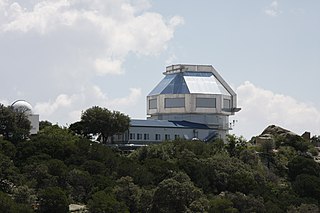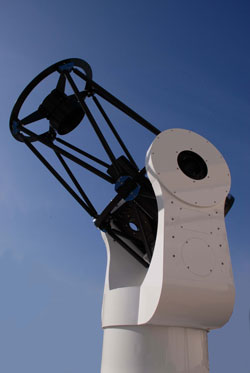Related Research Articles

The WIYN Observatory is owned and operated by the WIYN Consortium. Its 3.5-meter telescope is the second largest optical telescope at Kitt Peak National Observatory in Arizona. Most of the capital costs for the observatory were provided by the University of Wisconsin–Madison, Indiana University, and Yale University, while the National Optical Astronomy Observatory (NOAO) provides most of the operating services. The NOAO is an institution of the United States; it is the national optical observatory program and supports a collection of ground-based telescopes at Kitt Peak as well as other locations.

Didier Patrick Queloz is a Swiss astronomer. He is the Jacksonian Professor of Natural Philosophy at the University of Cambridge, where he is also a fellow of Trinity College, Cambridge, as well as a professor at the University of Geneva. Together with Michel Mayor in 1995, he discovered 51 Pegasi b, the first extrasolar planet orbiting a Sun-like star, 51 Pegasi. For this discovery, he shared the 2019 Nobel Prize in Physics with Mayor and Jim Peebles. In 2021, he was announced as the founding director of the Center for the Origin and Prevalence of Life at ETH Zurich.

The High Accuracy Radial Velocity Planet Searcher (HARPS) is a high-precision echelle planet-finding spectrograph installed in 2002 on the ESO's 3.6m telescope at La Silla Observatory in Chile. The first light was achieved in February 2003. HARPS has discovered over 130 exoplanets to date, with the first one in 2004, making it the most successful planet finder behind the Kepler space observatory. It is a second-generation radial-velocity spectrograph, based on experience with the ELODIE and CORALIE instruments.

Gliese 581b or Gl 581b is an exoplanet orbiting within the Gliese 581 system. It is the first planet discovered of three confirmed in the system so far, and the second in order from the star.

The Automated Planet Finder (APF) Telescope a.k.a. Rocky Planet Finder, is a fully robotic 2.4-meter optical telescope at Lick Observatory, situated on the summit of Mount Hamilton, east of San Jose, California, USA. It is designed to search for extrasolar planets in the range of five to twenty times the mass of the Earth. The instrument will examine about 10 stars per night. Over the span of a decade, the telescope is expected to study 1,000 nearby stars for planets. Its estimated cost was $10 million. The total cost-to-completion of the APF project was $12.37 million. First light was originally scheduled for 2006, but delays in the construction of the major components of the telescope pushed this back to August 2013. It was commissioned in August 2013.

Gliese 581d was a candidate extrasolar planet orbiting within the Gliese 581 system, approximately 20.4 light-years away in the Libra constellation. It was the third planet claimed in the system and the fourth or fifth in order from the star. Multiple subsequent studies found that the planetary signal in fact originates from stellar activity, and thus the planet does not exist.

Doppler spectroscopy is an indirect method for finding extrasolar planets and brown dwarfs from radial-velocity measurements via observation of Doppler shifts in the spectrum of the planet's parent star. As of November 2022, about 19.5% of known extrasolar planets have been discovered using Doppler spectroscopy.
An astro-comb is a type of frequency comb used in observational astronomy to increase the accuracy of wavelength calibration in spectrographs. The increased accuracy reduces systematic errors and enhances detection of small variations in stellar radial velocities caused by smaller orbiting exoplanets, among other applications. Astro-combs are distinguished from conventional frequency combs by their focus on high repetition frequencies.

Gliese 581e or Gl 581e is an exoplanet orbiting within the Gliese 581 system, located approximately 20.4 light-years away from Earth in the Libra constellation. It is the third planet discovered in the system and the first in order from the star.
The SOPHIEéchelle spectrograph is a high-resolution echelle spectrograph installed on the 1.93m reflector telescope at the Haute-Provence Observatory located in south-eastern France. The purpose of this instrument is asteroseismology and extrasolar planet detection by the radial velocity method. It builds upon and replaces the older ELODIE spectrograph. This instrument was made available for use by the general astronomical community October 2006.

The Mount Abu InfraRed Observatory (MIRO) is located near the town Mount Abu in the state of Rajasthan, India. The observatory is at an altitude of 1680 metres and is adjacent to Guru Shikhar, highest peak of the Aravalli Range. The 1.2 m infrared telescope at It is the first major facility in India specifically designed for ground-based, infrared observations of celestial objects. Further the low amount of precipitable water vapour at Guru Shikhar makes it a good site for the infrared telescope observations. The site has been found to be good for astronomical observations.

The Magellan Planet Search Program is a ground-based search for extrasolar planets that makes use of the radial velocity method. It began gathering data in December 2002 using the MIKE echelle spectrograph mounted on the 6.5m Magellan II "Clay" telescope located within the Las Campanas Observatory in Chile. In 2010, the program began using the newly commissioned Planet Finder Spectrograph (PFS), an instrument purpose-built for precise radial velocity measurement.

The Gemini Planet Imager (GPI) is a high contrast imaging instrument that was built for the Gemini South Telescope in Chile. The instrument achieves high contrast at small angular separations, allowing for the direct imaging and integral field spectroscopy of extrasolar planets around nearby stars. The collaboration involved in planning and building the Gemini Planet imager includes the American Museum of Natural History (AMNH), Dunlap Institute, Gemini Observatory, Herzberg Institute of Astrophysics (HIA), Jet Propulsion Laboratory, Lawrence Livermore National Lab (LLNL), Lowell Observatory, SETI Institute, The Space Telescope Science Institute (STSCI), the University of Montreal, University of California, Berkeley, University of California, Los Angeles (UCLA), University of California, Santa Cruz (UCSC), University of Georgia.

ESPRESSO is a third-generation, fiber fed, cross-dispersed, echelle spectrograph mounted on the European Southern Observatory's Very Large Telescope (VLT). The unit saw its first light on September 25, 2016.
HARPS-N, the High Accuracy Radial velocity Planet Searcher for the Northern hemisphere is a high-precision radial-velocity spectrograph, installed at the Italian Telescopio Nazionale Galileo, a 3.58-metre telescope located at the Roque de los Muchachos Observatory on the island of La Palma, Canary Islands, Spain.
HD 4747 is a star that lies approximately 61 light-years away in the constellation of Cetus. The star is a low-amplitude spectroscopic binary, with the secondary being a directly detected brown dwarf.

GJ 1151 is a star located in the northern circumpolar constellation of Ursa Major at a distance of 26.2 light-years from the Sun. It has a reddish hue and is too faint to be visible to the naked eye with an apparent visual magnitude of 14.0 The star is moving closer with a radial velocity of −36 km/s, and has a relatively large proper motion, traversing the celestial sphere at a rate of 1.815″·yr−1.

The MINiature Exoplanet Radial Velocity Array (MINERVA) is a ground-based robotic dedicated exoplanet observatory. The facility is an array of small-aperture robotic telescopes outfitted for both photometry and high-resolution Doppler spectroscopy located at the U.S. Fred Lawrence Whipple Observatory at Mt. Hopkins, Arizona. The project's principal investigator is the American astronomer Jason Eastman. The telescopes were manufactured by PlaneWave Instruments.
MINERVA-Australis is a dedicated exoplanet observatory, operated by the University of Southern Queensland, in Queensland, Australia. The facility is located at USQ's Mount Kent Observatory, and saw first light in quarter two 2018. Commissioning of the facility was completed in mid-2019, and the facility was officially launched on 23 July 2019.

K2-236b is a Neptune-like exoplanet that orbits an F-type star. It is also called EPIC 211945201 b. Its mass is 27 Earths, it takes 19.5 days to complete one orbit of its star, and is 0.148 AU from its star. Its discovery was announced in 2018. This was the first exoplanet discovered by scientists based in India. The discoverers were Abhijit Chakraborty (PRL), Arpita Roy (Caltech), Rishikesh Sharma (PRL), Suvrath Mahadevan, Priyanka Chaturvedi, Neelam J.S.S.V Prasad (PRL), and B. G. Anandarao (PRL).
References
- ↑ Chakraborty, Abhijit & Mahadevan, Suvrath & Roy, Arpita & M. Pathan, Fazalahmed & Shah, Vishal & H. Richardson, Eric & Ubale, Girish & Shah, Rajesh. (2010). First light results from PARAS: The PRL Echelle spectrograph. Proc SPIE. 7735. doi : 10.1117/12.856555.
- Roy, Arpita; Chakraborty, Abhijit; Mahadevan, Suvrath; Chaturvedi, Priyanka; Prasad, Neelam J.S.S.V.; Shah, Vishal; Pathan, F. M.; Anandarao, B. G. (2016). "Precision velocimetry planet hunting with PARAS: Current performance and lessons to inform future extreme precision radial velocity instruments". In Evans, Christopher J; Simard, Luc; Takami, Hideki (eds.). Ground-based and Airborne Instrumentation for Astronomy VI. Vol. 9908. pp. 99086R. arXiv: 1607.06485 . doi:10.1117/12.2232833. S2CID 119203005.
- ISRO’s PRL scientists discover an ‘EPIC’ planet

